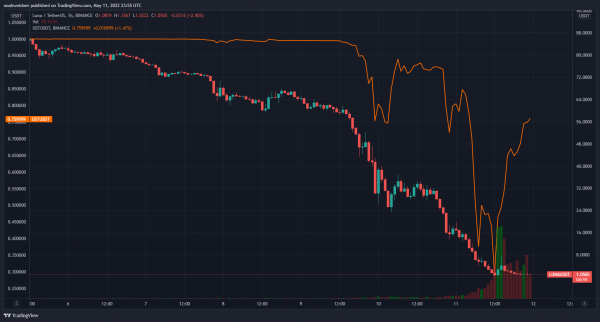Happy Wednesday. It’s May 11, 2022.
We hate to be the bear of bad news, but today — and the last week or so, for that matter — have not been happy times in both equities and crypto markets.
Let’s face it, though: it’s much worse in crypto and DeFi world.
Bitcoin and Ethereum are now down over -28% in the last seven days. Bitcoin was down -7% today, while Ethereum was down -10.8%.
Outside of the crypto royalty, things aren’t looking much better:
⛰️ Avalanche has lost half of its value this week, and more than -29.1% today.
📉 The Total Value Locked (TVL) of Curve dropped more than -20% today — pretty nuts.
🦍 ApeCoin is now down -63% in a single week and the Bored Apes’ creators’ new NFT, Otherdeeds, is trading below their original buy (mint) price…
🌳👻 Oh, and how could we forget? Terra has fallen by -98% this week and Fantom is down -63% as well.
Let us put this into perspective for you: things are so bad that today’s biggest gainer in the top 100 coins is a stablecoin…TerraUSD is up 1.5% today. We’re going to be touching on the Terra drama below.
All the money leaving crypto (or getting liquidated) is starting to feel like the nail in the coffin for this bull run. The money always seems to comes back, but many traders are taking losses and will sit on the sidelines as the market regresses to its new lows.
Here are today’s moves… and yes, UST is still an honorary member of our top-10 list.
| Bitcoin (BTC) |
$28,746
|
-7.34% |
| Ether (ETH) |
$2,065.43
|
-12.03% |
| Binance Coin (BNB) |
$268.36
|
-15.66% |
| Ripple (XRP) |
$0.4076
|
-20.71% |
| Cardano (ADA) |
$0.511
|
-19.18% |
| Solana (SOL) |
$48.78
|
-48.76% |
| Dogecoin (DOGE) |
$0.08406
|
-22.99% |
| TerraUSD (UST) |
$0.7969
|
+1.51% |
| Polkadot (DOT) |
$9.22
|
-26.91% |
| Avalanche (AVAX) |
$30.54
|
-31.79% |
Earnings
The Pain Coin-tinues for Coinbase
The crypto market is down… and so is Coinbase, America’s biggest crypto exchange.
The company reported net revenue of $1.165 billion (-27%) in the quarter, which was down both QoQ and YoY. Coinbase reported a $430 million loss in net income, or a loss of $1.98/share. Adjusted EBITDA came out to a gain of $20 million.
All of the figures were below analysts’ estimates, but Coinbase indicated that the results were within the company’s outlook. Perhaps most notable was a stat pulled out in the leading graphic of the company’s shareholder letter which showed that Coinbase spent more on its tech & development, sales & marketing, and general/administrative expenses than it made in revenue.
So, what gives? Well, retail-contrived transaction revenue commands a massive impact on Coinbase’s quality of earnings: it was $965 million of the company’s $1.01 billion in transaction revenue. That’s because the fee structure for consumers — e.g: a $2.99 fee on a $100 trade — is multiples higher than the fee structure for more seasoned traders and institutions, which prices trade fees in basis points.
So, when retail investors stop trading… it’s bad for Coinbase. And in Q1 2022, that’s what happened. Retail buying volume only made up $74 billion of the company’s $309 billion in trade volume, which was already down -44% YoY. That was in spite of a +50% YoY rise in monthly transacting users (MTUs).
Even though institutions kept their foot on the gas in terms of volume traded in the quarter, they only helped Coinbase generate $47 million in transaction revenue in the quarter.
The remainder of the company’s $151.9 million in revenue came from subscription and services revenue. That counts as the staking rewards cut Coinbase takes, “custodial fee revenue,” or revenue from Coinbase Earn campaigns, interest income, and “other” revenue that the company does not categorize.
A lot of $COIN‘s struggles can be attributed to volatility and some newfound weakness in the crypto markets. Crypto’s brightest days feel distant now, thanks to the Fed’s crack team of macroeconomists and interest rate lever-pullers. 🤷 And the more that the Fed, and other central banks, pull their levers, the lower it seems crypto will go. 📉
In the immediate aftermath of the report, Coinbase also tried to clear up concerns around a new disclosure that investors took to mean that the company faced bankruptcy risk. Investors construed the disclaimer to mean that Coinbase could seize assets from users in the case that they went under, which would — for obvious reasons — be very bad. It reads pretty plainly, but Coinbase CEO Brian Armstrong insists that they are not concerned about bankrtupcy.
That turned a bad report into a really bad compound sandwich of problems. $COIN fell more than 20% on the day of the earnings call before booking an additional -26% dip. As of this writing, it was sitting at a $12 billion market cap.
This past weekend, things got very hairy in the crypto market — coins started dropping across the board. By Monday evening, it looked like “just another crypto crash.” Billions of dollars of value were erased.
However, every crash has its catalyst — and for this one, it wasn’t the collapse of an exchange, ICO scams, or some mutual agreement among market participants that things needed to cool off. Instead, at the center of this collapse was Bitcoin and its tangential relationship with the Terra blockchain.
Terra, which has been described as a chain for stablecoins and assets, was the issuer of the world’s most-valuable algorithmic stablecoin. That stablecoin, $UST, had over $19 billion in circulation before this weekend. That coin, which is supposed to be worth $1.00, was kept at that price point by software.
Several weeks ago, we documented the early days of the Terra-Bitcoin love story: the Luna Foundation Guard (LFG) and Terra’s most foremost figure, Do Kwon, indicated their desire to back the Terra stablecoins with Bitcoin. In the eyes of Do Kwon and the LFG, this backing would help maintain its $1.00 peg.
Unfortunately, that all unfolded this week after a slew of liquidity attacks sent the stablecoin stumbling off its $1 peg. The attackers assumed that LFG, which had acquired billions worth of Bitcoin, would defend its peg before it defended its deposits. So far, that math has worked out.
$UST has traded as low as $0.20 since this drama unfolded… so, in short, it’s doing a very bad job of staying stable. At the time of our last edition of The Litepaper, $UST was sitting around $0.70, and we detailed one way that the LFG detailed for how it would try to defend the peg. Ultimately, it didn’t work — and so scores of LUNAtics laid in wait.
After waiting for days, the blockchain’s leader Do Kwon offered new insight into the next steps for recovering the Terra chain and its prized UST peg in a tweet chain.
In it, he indicates that “the only path forward will be to absorb the stablecoin supply that wants to exit before $UST can start to repeg.” He offered a proposal for the community to vote on which should affect how quickly the system could absorb UST.
However, he offers concessions — adding that rebuilding $UST to last will likely necessitate moving away from its novel “algorithmic stablecoin”/software mechanics. It insinuates that $UST will be collateralized, or backed by assets, in the future. This statement fares badly for other “competing” algorithmic stables, but offers a boost of confidence to long-standing overcollateralized (meaning: backed by more than is in circulation) stablecoins.
In the aftermath of Do Kwon’s tweet, $UST moved back up to the mid-$0.70s. However, $LUNA.X looked ready to go sub-$1. In this chart, $UST is represented in orange (its pricing on the left) while $LUNA.X is represented by the bars (and its pricing is on the right.)

In the case that happens, people would presumably be able to redeem $LUNA.X for $UST at a discount (which won’t mean much until it actually hits the current price of $UST, seeing as though it’s already below the peg.) However, this might actually increase the likelihood that $LUNA.X and $UST might be able to return to parity.
Or, maybe it just won’t… it’s anybody’s best guess at this stage in the game.
$LUNA.X fell more than -93% today, bringing its cumulative losses this week to -98%.
Sports’ biggest blockchain is ready to shell out mega millions to grow its share of the crypto pie. The Flow blockchain — which is home to Dapper Studios’ NBA Top Shot, UFC Strike, and NFL ALL DAY — announced a $725 million ecosystem fund to support development.
The official Flow Twitter claims that the fund is “the largest joint fund made for any blockchain.” They also claim that access to the fund will be available for the 7,500+ current Flow developers, along with the unknown quantity of future ones.
On the chain’s new ecosystem-specific page, developers can apply for a number of funds. Among them are Developer Grants, Ecosystem Investments, Fundraising Support, and the $10 million Dapper Studio Ecosystem Fund, which supports people building for Dapper’s aforementioned suite of NFT platforms. Dapper Studio is separate (but related) to Dapper Labs, the team beyond Flow.
The fund was supported by Andreessen Horowitz (a16z), Digital Currency Group, Spartan, Coatue, Union Square Ventures, and others. As part of their pledge, they will receive the chain’s token ($FLOW) and equity in Dapper Labs, the developers of the chain.
Dapper Labs, the developer of the three aforementioned NFT platforms, was a first-mover in the NFT space. The company created the CryptoKitties, which was one of the first platforms to use Ethereum’s long-standing ERC-721 token standard. After recognizing congestion problems on Ethereum, the company decided to invest in building its own chain — which has become what Flow is today.
Some of the benefits of the chain? Well, it isn’t slow like Ethereum — and it won’t need a whole update (Eth2) to give it a shot at being faster. It also has prided itself on being more “developer-friendly” and standards-based. However, in spite of its benefits, it has long been-assailed as being “more centralized”, something which it claims to have resolved as of Oct. 2021.
$FLOW.X was down 22% today in spite of the news, but that’s to be expected given how poor the markets have been. The crypto was #52 in market capitalization as of this writing.

